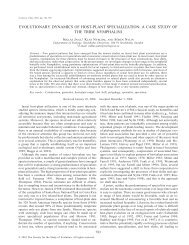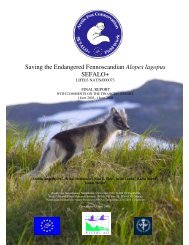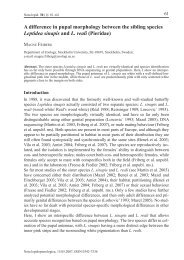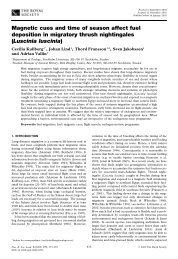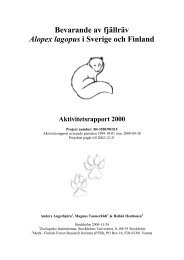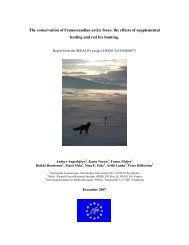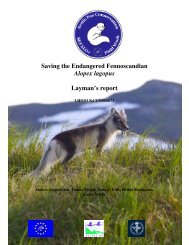Elmhagen et al. 1275al. 1999). To assess the importance of competition <strong>between</strong><strong>arctic</strong> <strong>and</strong> <strong>red</strong> <strong>foxes</strong>, it is therefore necessary to study their<strong>niche</strong> <strong>overlap</strong>, <strong>and</strong> food <strong>niche</strong> is one dimension.Arctic <strong>foxes</strong> in Fennosc<strong>and</strong>ia <strong>and</strong> other inl<strong>and</strong> habitatstypically use lemmings as their primary prey, but they alsoinclude voles, birds, eggs, hares, insects, berries, <strong>and</strong> carcassesof reindeer or caribou (Rangifer tar<strong>and</strong>us) in theirdiet (Macpherson 1969; Angerbjörn et al. 1999; Str<strong>and</strong> et al.1999; Dalerum <strong>and</strong> Angerbjörn 2000; Elmhagen et al. 2000).Voles are usually the most important prey for <strong>red</strong> <strong>foxes</strong>in Sweden <strong>and</strong> northern Europe, but birds, eggs, roe deer(Capreolus capreolus), lagomorphs, insects, fruit, <strong>and</strong> berriesare also fed upon (Englund 1965; Lindström 1989; Goszczynski1974; Leckie et al. 1998; O’Mahony et al. 1999). In a review,Hersteinsson <strong>and</strong> Macdonald (1982) concluded thatboth <strong>arctic</strong> <strong>and</strong> <strong>red</strong> <strong>foxes</strong> are highly opportunistic, <strong>and</strong> suggestedthat the more limited prey base in <strong>arctic</strong> areas is theonly reason why <strong>arctic</strong> fox populations often have a less varieddiet than <strong>red</strong> fox populations. This assumption is supportedby the results of a feeding experiment in which <strong>foxes</strong>could choose <strong>between</strong> already dead prey of different species:neither <strong>red</strong> <strong>foxes</strong> nor <strong>arctic</strong> <strong>foxes</strong> showed a preference forvoles or lemmings (Barth et al. 2000). On the contrary, threedietary studies involving sympatric <strong>arctic</strong> <strong>and</strong> <strong>red</strong> <strong>foxes</strong> showedthat <strong>arctic</strong> <strong>foxes</strong> generally eat more lemmings <strong>and</strong> fewervoles than <strong>red</strong> <strong>foxes</strong> do, <strong>and</strong> it was suggested that <strong>red</strong> <strong>foxes</strong>could be more generalistic feeders (Smits et al. 1989; Frafjord1995; Frafjord 2000). However, the samples in the two earlierstudies were very small <strong>and</strong> none of the studies providedany data on prey availability. Thus, it is not possible to determinewith certainty what causes the observed dietary differences.Either <strong>arctic</strong> <strong>and</strong> <strong>red</strong> <strong>foxes</strong> could have differenthunting behaviours that result in different prey preferences,or they could be segregated on a small spatial scale <strong>and</strong>therefore have access to different prey bases in areas wherethey are regarded as sympatric. Differences in prey preferencesindicate that there is food-<strong>niche</strong> separation <strong>between</strong>the fox species <strong>and</strong> that competition may be of less importance.However, if there are no fundamental food-<strong>niche</strong> differences,spatial segregation could result from interspecificcompetition.The best way to determine if two species compete is tocompare “actual” <strong>and</strong> “virtual” <strong>niche</strong> <strong>overlap</strong>s, these beingthe local population equivalents of the realised <strong>and</strong> fundamental<strong>niche</strong>s of an entire species (Colwell <strong>and</strong> Futuyma1970). For example, food competition <strong>between</strong> mink (Mustelavision) <strong>and</strong> otter (Lutra lutra) was investigated throughcomparisons of food-<strong>niche</strong> breadths <strong>and</strong> food-<strong>niche</strong> <strong>overlap</strong>sunder sympatric <strong>and</strong> allopatric conditions (Clode <strong>and</strong> Macdonald1995). In Fennosc<strong>and</strong>ia there are no areas of mountaintundra where <strong>red</strong> <strong>foxes</strong> are absent to the extent that wecould study the “virtual diet” of the <strong>arctic</strong> fox. However, wecan test whether there is small-scale spatial segregation <strong>between</strong>the species with respect to altitude, an important habitatvariable. Further, lemming <strong>and</strong> vole populations fluctuateover time <strong>and</strong> relative abundances change from year to yearat all altitudes (Oksanen et al. 1999). Thus, we can alsostudy how <strong>arctic</strong> <strong>and</strong> <strong>red</strong> <strong>foxes</strong> respond to differences in preyspecies composition. If there are species-specific differencesin prey preferences, i.e., if <strong>arctic</strong> <strong>and</strong> <strong>red</strong> <strong>foxes</strong> have differenthunting behaviours, they will respond differently to changesin the composition of the prey community. Consequently,the degree of <strong>niche</strong> <strong>overlap</strong> will vary <strong>between</strong> years. If, instead,they use prey similarly, <strong>niche</strong> <strong>overlap</strong>s should be relativelyconstant in time. There are four possible scenariosdepending on the existence of spatial segregation <strong>and</strong> (or)species-specific prey use: (1) No spatial segregation, no differencesin prey preferences: <strong>arctic</strong> <strong>and</strong> <strong>red</strong> <strong>foxes</strong> have thesame diets, i.e., food-<strong>niche</strong> <strong>overlap</strong> is 100%. (2) No spatialsegregation, different prey preferences: <strong>arctic</strong> <strong>and</strong> <strong>red</strong> <strong>foxes</strong>have different diets <strong>and</strong> the degree of food-<strong>niche</strong> <strong>overlap</strong>changes <strong>between</strong> years. (3) Spatial segregation, no differencesin prey preferences: <strong>arctic</strong> <strong>and</strong> <strong>red</strong> <strong>foxes</strong> have differentdiets, owing to differences in the composition of the preycommunity at different altitudes, but the degree of food<strong>niche</strong><strong>overlap</strong> is consistent <strong>between</strong> years. (4) Spatial segregation,different prey preferences: <strong>arctic</strong> <strong>and</strong> <strong>red</strong> <strong>foxes</strong> havedifferent diets <strong>and</strong> the degree of food-<strong>niche</strong> <strong>overlap</strong> changes<strong>between</strong> years.In this study we investigated the summer diets of sympatric<strong>arctic</strong> <strong>and</strong> <strong>red</strong> <strong>foxes</strong> over 4 years to find out which scenariois enacted on the Fennosc<strong>and</strong>ian mountain tundra. We testfor dietary differences <strong>between</strong> <strong>arctic</strong> <strong>and</strong> <strong>red</strong> <strong>foxes</strong>, foraltitudinal segregation <strong>between</strong> these species, <strong>and</strong> for an effectof altitude on the occurrence of different prey species intheir diets. We also study whether food-<strong>niche</strong> <strong>overlap</strong> <strong>and</strong>food-<strong>niche</strong> breadth change <strong>between</strong> years. Finally, we discussthe implications of <strong>arctic</strong> <strong>and</strong> <strong>red</strong> fox food <strong>niche</strong>s forthe degree of interspecific competition.Materials <strong>and</strong> methodsStudy areaThe study area cove<strong>red</strong> 1300 km 2 of mountain tundra inthe Vindelfjällen Nature Reserve in Swedish Lapl<strong>and</strong> (66°N,16°E). The main vegetation types were dry heath, grass heath,<strong>and</strong> dry fen. Plant-species diversity was low, except for somerelatively rich patches (Rune 1981). Arctic <strong>foxes</strong> b<strong>red</strong> onlyabove the tree line, which was situated at 750 m asl. Most<strong>red</strong> <strong>foxes</strong> breed below the tree line, in birch <strong>and</strong> coniferousforests, but all <strong>red</strong> <strong>foxes</strong> included in this study inhabited former<strong>arctic</strong> fox dens on the mountain tundra. These dens arehereinafter refer<strong>red</strong> to as <strong>red</strong> fox dens. Prey species availableto the <strong>foxes</strong> were Norwegian lemming (Lemmus lemmus), fieldvole (Microtus agrestis), bank vole (Clethrionomys glareolus),grey-sided vole (Clethrionomys rufocanus), shrews (Sorex spp.),mountain hare (Lepus timidus), reindeer, rock ptarmigan(Lagopus mutus), willow ptarmigan (Lagopus lagopus), passerines(Passeriformes), ducks (Anseriformes), gulls, <strong>and</strong> waders(Charadriiformes).Lemming <strong>and</strong> vole populations are generally cyclic in <strong>arctic</strong><strong>and</strong> mountain tundra areas (Elton 1924; Hanski et al.1991; Angerbjörn et al. 2001), but there have been occasionalprolonged interruptions in the cycle in Fennosc<strong>and</strong>ia(Angerbjörn et al. 2001). During these, lemming populationsfluctuate with a periodicity resembling the normal cycle, butthe amplitude is smaller than usual. The interruptions havetherefore been described as periods without peak years, sincethe highest lemming densities are about 10 times lower th<strong>and</strong>uring “real” peaks (Angerbjörn et al. 2001; Tannerfeldt etal. 2002). The last lemming peak in Sweden occur<strong>red</strong> in1982, consequently our study was carried out during one of© 2002 NRC Canada
1276 Can. J. Zool. Vol. 80, 2002these periods. However, trapping data from our study areashowed that lemming abundance fluctuated <strong>between</strong> years<strong>and</strong> the highest summer density was at least 20 times higherthan during population low phases (Ecke et al. 2001). Theabundance of nesting birds does not change significantly <strong>between</strong>years, although nesting success can vary (Svensson etal. 1984). We have no information on fluctuations in thereindeer <strong>and</strong> hare populations. Other p<strong>red</strong>ators in the areathat could interact with the fox species were wolverines(Gulo gulo) <strong>and</strong> golden eagles (Aquila chrysaëtos).Collection of scats <strong>and</strong> scat analysisWe have surveyed <strong>arctic</strong> fox dens in our study area since1985. We regard a den as inhabited when we observe foxcubs <strong>and</strong> (or) adult <strong>foxes</strong> regularly returning to <strong>and</strong> stayingat it. We also regard a den as inhabited when the amount offresh scats, prey remains, recently excavated openings, <strong>and</strong>wear <strong>and</strong> tear on the vegetation surrounding the openings indicatesthat the den is used to this extent, even though no<strong>foxes</strong> are seen. Arctic <strong>and</strong> <strong>red</strong> fox families occasionally moveduring summer (Tannerfeldt et al. 2002). In such cases weonly used scats from one of the dens in our analyses. Thus,within the same summer, scats collected at different densrepresent different <strong>foxes</strong>.In the summers of 1993 <strong>and</strong> 1996–1998, we collectedscats from all dens inhabited by <strong>arctic</strong> or <strong>red</strong> <strong>foxes</strong>. Lemmingnest counts <strong>and</strong> snap-trapping data showed that thelemming population was in the low phase in 1993, increasedin 1996, decreased (crashed) in 1997, <strong>and</strong> remained low in1998 (Ecke et al. 2001; Tannerfeldt et al. 2002). Scats werealso collected in 1994 <strong>and</strong> 1995, but most were unfortunatelylost during storage, owing to a non-underst<strong>and</strong>ingmother. Most of the <strong>arctic</strong> fox scats collected in 1996 <strong>and</strong>1997 were also included in an earlier study on <strong>arctic</strong> fox diet(Elmhagen et al. 2000).We separated fresh scats, i.e., collected during the currentsummer, from older ones by their colour, position in the vegetation,<strong>and</strong> smell (Macpherson 1969; Birks <strong>and</strong> Penford1990). We made visual observations of <strong>foxes</strong> at all <strong>arctic</strong> foxdens but at only 6 of 10 <strong>red</strong> fox dens. When we did not seeany <strong>foxes</strong>, we relied on the presence of tracks <strong>and</strong> fur <strong>and</strong>the size of openings of newly excavated dens to determinewhich species used the den. We collected scats only at inhabiteddens, so there was little risk of confusing <strong>arctic</strong> <strong>and</strong><strong>red</strong> fox scats. There were cubs in all dens where we saw<strong>foxes</strong>, except in 1997, when the lemming population was inthe crash phase. In that year, one cub that died early wasseen at one of three dens inhabited by <strong>arctic</strong> <strong>foxes</strong>, whilethere were cubs at one of two dens inhabited by <strong>red</strong> <strong>foxes</strong>.There can be differences <strong>between</strong> the prey eaten by adult<strong>foxes</strong> themselves <strong>and</strong> those they bring to their cubs (Lindström1994). However, Frafjord (2000) found only one significantdifference in <strong>foxes</strong>’ diets <strong>between</strong> dens with <strong>and</strong> withoutcubs: insects occur<strong>red</strong> more often in scats from <strong>red</strong> fox denswith cubs, though insects were not an important prey item.We therefore assumed that the scats from each den gave afair representation of the prey caught by the adult <strong>foxes</strong>, independentlyof the proportion of adult to juvenile scats.Scats were dried at 105°C prior to analysis. Small or fragmentedscats were combined, so the analysed volume ofeach sample was approximately that of one medium-sizedscat. Such samples are hereinafter refer<strong>red</strong> to as single scats.When more than 20 scats had been collected from a den, wer<strong>and</strong>omly picked 20 for analysis. The total sample consistedof 293 <strong>arctic</strong> fox scats <strong>and</strong> 177 <strong>red</strong> fox scats from 15 <strong>and</strong> 9dens, respectively.We fragmented individual scats by h<strong>and</strong> under a magnifyingglass. We noted occurrences of different prey items <strong>and</strong>estimated the percent dry volume of mammal fur <strong>and</strong> bones,feathers, eggshells, insects, <strong>and</strong> vegetation by eye. We convertedthese volume estimates to “whole-scat equivalents” asdescribed by Angerbjörn et al. (1999). We summarized thepercent volumes of each food category in the scats collectedat the same den.Fur was identified as reindeer, hare, fox, or small mammalby means of a reference collection <strong>and</strong> microscopic charactersdescribed by Day (1966). We igno<strong>red</strong> single fox hairs<strong>and</strong> small tufts of fox hair that probably resulted from grooming.We determined lemming <strong>and</strong> vole species using descriptionsof molars in Niethammer <strong>and</strong> Krapp (1982). We didnot distinguish <strong>between</strong> bank vole <strong>and</strong> grey-sided vole, butused the category Clethrionomys spp. Shrews were also identifiedby the presence of teeth, but we did not discriminate<strong>between</strong> species. When teeth from more than one smallmammalspecies were found in the same scat, we used thenumber of teeth from each species to partition the volumesof fur <strong>and</strong> small-mammal bones among them. When therewere no teeth in a scat, small-mammal fur was classified as“unidentified small mammals” (Tables 1 <strong>and</strong> 3). For estimatingvolume, calculating <strong>niche</strong> <strong>overlap</strong> <strong>and</strong> <strong>niche</strong> breadth, <strong>and</strong>correlating the frequencies of occurrence of different preyitems with altitude, we assumed that the total volumes ofunidentified small mammals in the scats were in the sameproportions as the total volumes of small-mammal specieswhich had been identified at each den (Figs. 1 <strong>and</strong> 2, Table4). Consequently, unidentified small mammals were distributedin these categories accordingly.During the analyses we noted that teeth from small mammalsoccur<strong>red</strong> less frequently relative to the presence ofsmall-mammal fur in some years, <strong>and</strong> generally less often in<strong>red</strong> fox scats than in <strong>arctic</strong> fox scats (Tables 1 <strong>and</strong> 3). Thisappea<strong>red</strong> to be related to the proportion of voles to lemmings.If <strong>foxes</strong> h<strong>and</strong>le lemmings differently from voles, theuse of teeth for estimating proportions of different smallmammals in the scats could result in a bias. However, if it isappropriate to use this method, the estimated proportions oflemmings, voles, <strong>and</strong> shrews should be approximately thesame if fur is used for identification. The fur of the Norwegianlemming is largely black <strong>and</strong> yellow, while the fur ofvoles <strong>and</strong> shrews is brown or greyish. We made coarse estimatesof the proportions of lemming <strong>and</strong> vole/shrew fur in25% steps from 0 to 100% for each scat. We compa<strong>red</strong> theresults obtained through identifying teeth (where unidentifiedsmall mammals were distributed in the categories ofidentified small-mammal species) with the estimates obtainedfrom fur using Spearman’s rank-correlation tests, where eachden was treated as one unit. The two methods gave very similarresults, with significant correlations for both <strong>arctic</strong> <strong>foxes</strong>(lemmings: p < 0.001, r S = 0.85, n = 15; voles/shrews: p



